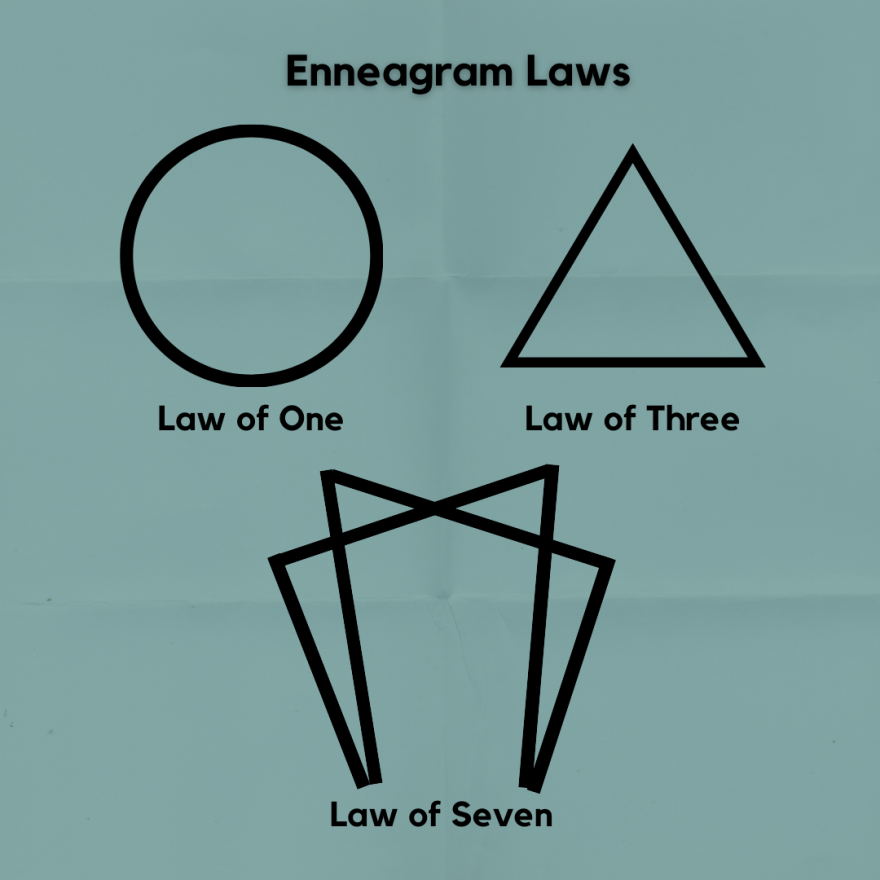The Enneagram Laws of One, Three, and Seven

The Enneagram Laws of One, Three, and Seven
Navigating the symbol of the Enneagram gives us the law of one, three and seven. In order to understand these laws it requires a short history lesson. So, the person responsible for bringing the symbol of the modern day Enneagram is George Ivanovich Gurdjieff. He was a Greek-American born around 1875 and who studied the science of human transformation. Gurdjieff explained that the Enneagram symbol is made up of three parts, the circle, the triangle, and the hexad. When you put these three elements together we get the Enneagram.
The first element is the circle, representing the law of one. The circle refers to a universal connection, unity, wholeness, and a oneness. The law of one asks, can we be one with all? Do you love this person, all people? Will you be part of this container, do you see that we are all a part of this together? An example of oneness could be a choir, all singing together in unison, or a lively dinner table, where all are enjoying themselves, talking, laughing, listening to each other. What is a way in which you experience wholeness? We all have times in our lives where we experience this sense of unity, a connection to all, the law of one.
Next is the triangle which represents the law of three, held within the circle. The law of three is the holding of two opposite forces. Think of a rubber band being held, stretched between the thumb and pointer finger on each hand, the rubber band is tight pulling it in opposite directions. If you can then relax the grip and create a third point in the middle, you create a balance point. This third force feels solid and creates a way to move through it, to move forward. The law of three is manifested in many ways, levels, and traditions. It is prevalent in various religious connotations, such as, the Christian tradition of the Holy Trinity, the Father, Son, and the Holy Spirit. The subatomic scale in physics has the structure of the atom which is made up of protons, electrons, and neutrons.
Gurdjieff said that we are often third force blind. We have a hard time seeing the balance point. For example, the usual way of looking at reality may be to see things in a duality such as black and white, man and woman, introvert and extrovert, or me and you. The ancient traditions, however, did not see black and white, but black, white, and gray. Also, instead of man and woman, it was man, woman, and child or me, you and us or we. Growth, strength, and stability can be created with the third force. What areas of your life could you create a third force, a balance point?
Then the third element is the hexad, the law of seven. When looking at the Enneagram symbol the hexad is made up of the seven types or points within the circle outside of the points on the triangle, so the numbers are 1, 4, 2, 8, 5, and 7. This diagram symbolizes a process, development, a dance where nothing is static and we are always moving and changing, becoming something else. The law of seven illustrates our growth path, the ability to transform, and evolve over time. This process beings and ends without a linear requirement. The law of seven shows up in many ways, for example, a rainbow has seven elements of moving light or the western musical octaves has seven notes.
When we combine all three of these elements, the circle, the triangle, and the hexad, we have the Enneagram. It is a symbol that shows us that we are in this together, a oneness or wholeness, the circle and the law of one. We have choice for creating stability through the interaction of three forces, the triangle and the law of three. We also, grow and change over time, the hexad and the law of seven. The Enneagram, Gurdjieff believed, has movement, is dynamic, and is meant to be a living symbol.
